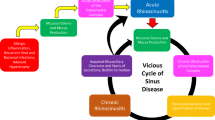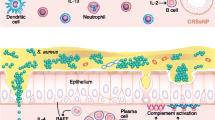Abstract
Eosinophilic chronic rhinosinusitis (ECRS) encompasses a wide variety of etiologies. To date, a unifying pathophysiologic mechanism remains elusive. Eosinophilia is frequently, but not exclusively, caused by immunoglobulin (Ig)E-mediated hypersensitivity and is dominated by the associated cytokine milieu of Th2 inflammation. The provisional subcategories of ECRS include superantigen-induced eosinophilic chronic rhinosinusitis, allergic fungal sinusitis, nonallergic fungal eosinophilic chronic rhinosinusitis, and aspirin-exacerbated eosinophilic chronic rhinosinusitis. Within each subcategory, recent findings supporting distinct mechanisms that promote eosinophilic infiltration are presented, and, therefore, targeted therapeutic interventions with specific antibacterial, antifungal, or immune modulation may be indicated.
Similar content being viewed by others
References and Recommended Reading
Benninger MS, Ferguson BJ, Hadley JA, et al.: Adult chronic rhinosinusitis: definitions, diagnosis, epidemiolog y, and pathophysiolog y. Otolaryngol Head Neck Surg 2003, 129(Suppl):S1-S32.
Lethbridge-Cxejku M, Schiller JS, Bernadel L: Summar y health statistics for U.S. adults: National Health Inter view Sur vey, 2002. National Center for Health Statistics. Vital Health Stat 2004, 10:222.
Bajracharya H, Hinthorn D: Sinusitis, Chronic. http:// www.emedicine.com/med/topic2556.htm. Accessed November 2005.
Meltzer EO, Hamilos DL, Hadley JA, et al.: Rhinosinusitis: establishing definitions for clinical research and patient care. J Allergy Clin Immunol 2004, 114 (6 Suppl):155–212.
Newman LJ, Platts-Mills TA, Phillips CD, et al.: Chronic sinusitis: relationship of computed tomographic findings to allerg y, asthma, and eosinophilia. JAMA 1994, 271:363–367.
Hoover GE, Newman LJ, Platts-Mills TA, et al.: Chronic sinusitis: risk factors for extensive disease. J Allergy Clin Immunol 1997, 100:185–191.
Szucs E, Ravandi S, Goossens A, et al.: Eosinophilia in the ethmoid mucosa and its relationship to the severity of inf lammation in chronic rhinosinusitis. Am J Rhinol 2002, 16:131–134.
Baroody FM, Hughes CA, McDowell P, et al.: Eosinophilia in chronic childhood sinusitis. Arch Otolaryngol Head Neck Surg 1995, 121:1396–402.
Sobol SE, Fukakusa M, Christodoulopoulos P, et al.: Inflammation and remodeling of the sinus mucosa in children and adults with chronic sinusitis. Laryngoscope 2003, 113:410–414. This small study of seven children, seven adults with CRS, and six control subjects found evidence of irreversible change in adults characterized by the deposition of collagen fibers, which exceeded that seen in children.
Chan KH, Abzug MJ, Coffinet L, et al.: Chronic rhinosinusitis in young children differs from adults: a histopatholog y study. J Pediatr 2004, 144:206–212.
Zadeh MH, Banthia V, Anand VK, et al.: Significance of eosinophilia in chronic rhinosinusitis. Am J Rhinol 2002, 16:313–317. This huge retrospective study found a surprisingly low number of patients with peripheral eosinophilia compared with other series. Nevertheless, it dramatically illustrates the poorer postoperative result achieved in patients with serum eosinophilia compared with those without serum eosinophilia.
Alam R, Busse W W: The eosinophil-quo vadis? J Allergy Clin Immunol 2004, 113:38–42. This short and entertaining editorial frames the question for the role and contribution of eosinophils in different disease states and outlines the putative role as well as the complexities involved in understanding this role.
Bochner BS: Verdict in the case of therapies versus eosinophils: the jur y is still out. J Allergy Clin Immunol 2004, 113:3–9. This is a comprehensive yet concise review of the eosinophil by a leader in the field, particularly as it relates to asthma. The figure of almost a hundred examples of surface molecules expressed by the human eosinophil in this article is worthy of review for anyone desiring more information about the eosinophil.
Dunnill MS: Pulmonar y fibrosis. Histopathology 1990, 16:321–329.
Weller PF: Human eosinophils. J Allergy Clin Immunol 1997, 100:283–287.
Ebisawa M, Schleimer RP, Bickel C, et al.: Phenotyping of purified human peripheral blood eosinophils using the blind panel mAb. In Leukocyte Typing V: White Cell Differentiation Antigens; Edited by Schlossman S, Boumsell L, Gilks W, et al. New York, NY: Oxford University Press; 1995:1036–1038.
Temple R, Allen E, Fordham J, et al.: Microarray analysis of eosinophils reveals a number of candidate sur vival and apoptosis genes. Am J Respir Cell Mol Biol 2001, 25:425–433.
Tachimoto H, Bochner BS: The surface phenotype of human eosinophils. Chem Immunol 2000, 76:45–62.
Leckie MJ, Brinke A, Khan J, et al.: Effects of an interleukin-5 blocking monoclonal antibody on eosinophils, airway hyper-responsiveness, and the late asthmatic response. Lancet 2000, 356:2144–2148.
O’Byrne PM, Inman MD, Parameswaran K: The trials and tribulations of IL-5, eosinophils, and allergic asthma. J Allergy Clin Immunol 2001, 108:503–508.
Liu LY, Sedgwick JB, Bates ME, et al.: Decreased expression of membrane IL-5 receptor alpha on human eosinophils: I. Loss of membrane IL-5 receptor alpha on airway eosinophils and increased soluble IL-5 receptor alpha in the airway after allergen challenge. J Immunol 2002, 169:6452–6458.
Mattes J, Yang M, Mahalingam S, et al.: Intrinsic defect in T cell production of interleukin (IL) -13 in the absence of both IL -5 and eota xin precludes the development of eosinophilia and air ways hyperreactivity in experimental asthma. J Exp Med 2002, 195:1433–44.
Lee JJ, Dimina D, Macias MP, et al.: Defining a link with asthma in mice congenitally deficient in eosinophils. Science 2004, 305:1773–1776.
Ir win MJ, Hudson KR, Fraser JD, et al.: Enterotoxin residues determining T-cell receptor V binding specificity. Nature 1992, 359:841–843.
Schubert MS: A superantigen hypothesis for the pathogenesis of chronic hypertrophic rhinosinusitis, allergic fungal sinusitis, and related disorders. Ann Allergy Asthma Immunol 2001, 87:181–188.
Schubert MS, Hutcheson PS, Graff RJ, et al.: HLA-DQB1 *03 in allergic fungal sinusitis and other chronic hypertrophic rhinosinusitis disorders. J Allergy Clin Immunol 2004, 114:1376–1383.
Bernstein JM, Ballow M, Schlievert PM, et al.: A superantigen hypothesis for the pathogenesis of chronic hyperplastic sinusitis with massive nasal polyposis. Am J Rhinol 2003, 17:321–326. This is the first study to show clonal expansion of the variable β region of the T-cell receptors unregulated by SE or superantigen. The author makes the case for superantigens from Staphylococcus as a cause for eosinophilic nasal polyposis.
Bernstein JM, Kansal R: Superantigen hypothesis for the early development of chronic hyperplastic sinusitis with massive nasal polyposis. Curr Opin Otolaryngol Head Neck Surg 2005, 13:39–44.
Seiberling KA, Conley DB, Tripathi A, et al.: Superantigens and chronic rhinosinusitis: detection of staphylococcal exotoxins in nasal polyps. Laryngoscope 2005, 115:1580–1585.
Bachert C, Gevaert P, Holtappels G, et al.: Total and specific IgE in nasal polyps is related to local eosinophilic inf lammation. J Allergy Clin Immunol 2001, 107:607–614.
Zhang N, Gevaert P, van Zele T, et al.: An update on the impact of Staphylococcus aureus enterotoxins in chronic sinusitis with nasal polyposis. Rhinology 2005, 43:162–168.
Hendricks A, Leibold W, Kaever V, et al.: Prostaglandin E2 is variably induced by bacterial superantigens in bovine mononuclear cells and has a regulator y role for the T cell proliferative response. Immunobiology 2000, 201:493–505.
Desouza IA, Franco-Penteado CF, Camargo EA, et al.: Inf lammator y mechanisms underlying the rat pulmonar y neutrophil inf lux induced by airway exposure to staphylococcal enterotoxin type A. Br J Pharmacol 2005, 146:781–791.
Casale TB, Condemi J, LaForce C, et al.: Effect of omalizumab on symptoms of seasonal allergic rhinitis: a randomized controlled trial. JAMA 2001, 286:2956–2967.
Chiang DT, Clark J, Casale TB: Omalizumab in asthma: approval and postapproval experience. Clin Rev Allergy Immunol 2005, 29:3–16.
National Institutes of Health: Xolair in Patients with Chronic Sinusitis. http://clinicaltrials.gov/show/ NCT00117611. Accessed November 2005.
Katsuyama M, Ichikawa H, Ogawa S, et al.: A novel method to control the balance of skin microf lora. Part 1. Attack on biofilm of Staphylococcus aureus without antibiotics. J Dermatol Sci 2005, 38:197–205.
Ferguson BJ, Stolz DB: Demonstration of biofilm in human bacterial chronic rhinosinusitis. Am J Rhinol 2005, 19:452–457.
Marple BF: Allergic fungal rhinosinusitis: current theories and management strategies. Laryngoscope 2001, 111:1006–1019.
Manning S, Mabry R, Schaefer S, et al.: Evidence of IgE-mediated hypersensitivity in allergic fungal sinusitis. Laryngoscope 1993, 103:717–721.
Collins M, Nair S, Smith W, et al.: Role of local immunoglobulin E production in the pathophysiolog y of noninvasive fungal sinusitis. Laryngoscope 2004, 114:1242–1246.
Pant H, Kette FE, Smith WB, et al.: Fungal-specific humoral response in eosinophilic mucus chronic rhinosinusitis. Laryngoscope 2005, 115:601–606.
Schubert MS: Antileukotriene therapy for allergic fungal sinusitis. J Allergy Clin Immunol 2001, 108:466–467.
Stevens DA, Schwartz HJ, Lee JY, et al.: A randomized trial of itraconazole in allergic bronchopulmonary aspergillosis. N Engl J Med 2000, 342:756–762.
Bassichis BA, Marple BF, Mabry RL, et al.: Use of immunotherapy and previously treated patients with allergic fungal sinusitis. Otolaryngol Head Neck Surg 2001, 125:487–490.
Marple B, Newcomer M, Schwade N, et al.: Natural history of allergic fungal rhinosinusitis: a 4-to 10-year followup. Otolaryngol Head Neck Surg 2002, 127:361–366.
Ponikau JU, Sherris DA, Kern EB, et al.: The diagnosis and incidence of allergic fungal sinusitis. Mayo Clin Proc 1999, 515:18–21.
Shin SH, Ponikau JU, Sherris DA, et al.: Chronic rhinosinusitis: an enhanced immune response to ubiquitous airborne fungi. J Allergy Clin Immunol 2004, 114:1369–1375.
Braun H, Buzina W, Freudenschuss K, et al.: Eosinophilic fungal rhinosinusitis: a common disorder in Europe? Laryngoscope 2003, 113:264–269.
Lebowitz RA, Waltzman MN, Jacobs J, et al.: Isolation of fungi by standard laboratory methods in patients with chronic rhinosinusitis. Laryngoscope 2002, 112:2189–2191.
Ferguson BJ: Eosinophilic mucin rhinosinusitis-a distinctive clinicopathological entity. Laryngoscope 2000, 110:799–813.
Ponikau J, Sherris D, Kita H, et al.: Intranasal antifungal treatment in 51 patients with chronic rhinosinusitis. J Allergy Clin Immunol 2002, 110:862–866. Although the authors report impressive success rates with topical antifungal in patients with CRS, their failure to include a control group renders the study inconclusive with regard to any efficacy from the antifungal.
Ricchetti A, Landis BN, Maffioli A, et al.: Effect of anti-fungal nasal lavage with amphotericin B on nasal polyposis. J Laryngol Otol 2002, 116:261–263.
Weschta M, Rimek D, Formanek M, et al.: Topical antifungal treatment of chronic rhinosinusitis with nasal polyps: a randomized, double-blind clinical trial. J Allergy Clin Immunol 2004, 113:1122–1128.
Ponikau JU, Sherris DA, Weaver A, et al.: Treatment of chronic rhinosinusitis with intranasal amphotericin B: a randomized, placebo-controlled, double-blinded pilot trial. J Allergy Clin Immunol 2005, 115:125–131.
Widal MF, Abrani P, Lermoyez J: Anaphylaxie et idiosyncrasie. Presse Med 1922, 30:189–192.
Szczeklik A, Stevenson DD: Aspirin-induced asthma: advances in pathogenesis, diagnosis, and management. J Allergy Clin Immunol 2003, 111:913–921. This review article comprehensively reviews the clinical as well as the pathophysiologic basis of aspirin-exacerbates ECRS. Stevenson pioneered aspirin desensitization almost 20 years ago.
Sousa AR, Parikh A, Scadding G, et al.: Leukotriene-receptor expression on nasal mucosal inflammatory cells in aspirin-sensitive rhinosinusitis. N Engl J Med 2002, 347:1493–1499. The authors conclude that the elevated expression of CysLT1 receptor in aspirin-exacerbated ECRS is probably fundamental to the pathogenesis of aspirin sensitivity and to the mechanism of aspirin desensitization.
Kowalski ML, Ptasinska A, Jedrzejczak M, et al.: Aspirintriggered 15-HETE generation in peripheral blood leukocytes is a specific and sensitive Aspirin-Sensitive Patients Identification Test (ASPITest). Allergy 2005, 60:1139–1145.
Lindsay RW, Slaughter T, Britton-Webb J, et al.: The development of a murine model of chronic rhinosinusitis. Otolaryngol Head Neck Surg, In press.
Ferguson BJ: Commentary: The development of a murine model of chronic rhinosinusitis. Otolaryngol Head Neck Surg, In press.
Author information
Authors and Affiliations
Corresponding author
Rights and permissions
About this article
Cite this article
Sok, J.C., Ferguson, B.J. Differential diagnosis of eosinophilic chronic rhinosinusitis. Curr Allergy Asthma Rep 6, 203–214 (2006). https://doi.org/10.1007/s11882-006-0036-1
Issue Date:
DOI: https://doi.org/10.1007/s11882-006-0036-1




